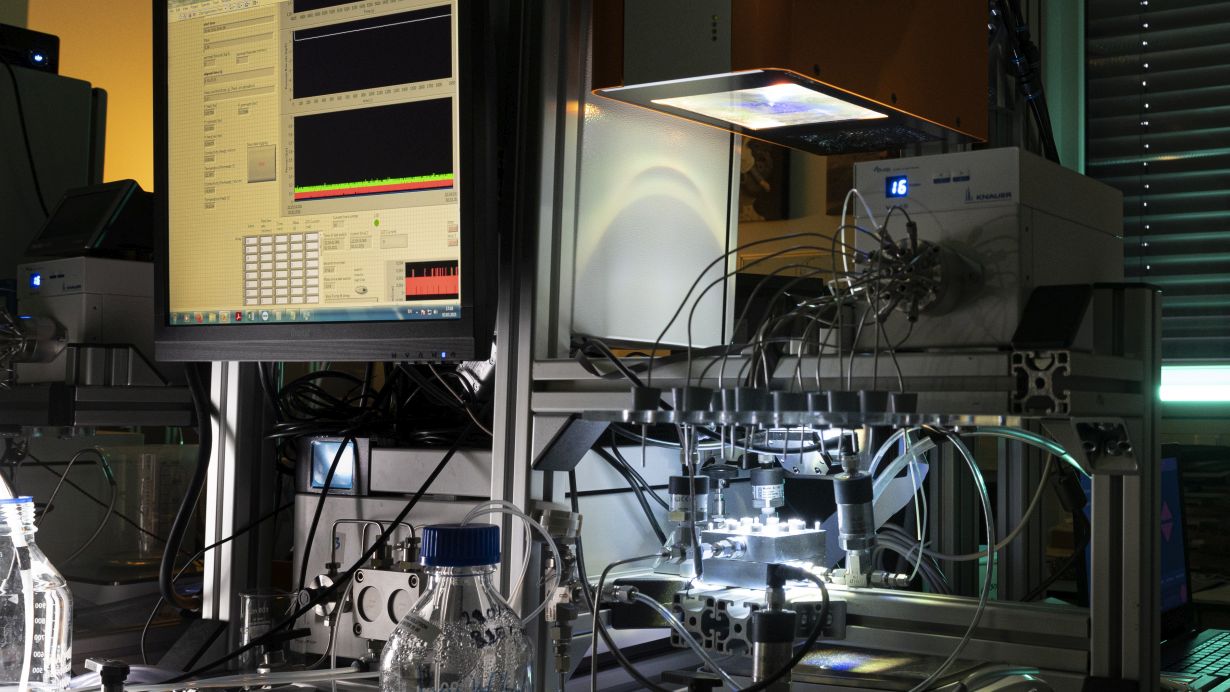Micropollutants in water often are hormones that accumulate in the environment and may have negative impacts on humans and animals. Researchers of Karlsruhe Institute of Technology (KIT) and Leibniz Institute of Surface Engineering (IOM) in Leipzig have now developed a process for the photocatalytic degradation of these pollutants when they flow through polymer membranes. It is presented in Nature Nanotechnology. Irradiation with light triggers a chemical reaction, as a result of which steroid hormones are degraded on the membranes coated with titanium dioxide. (DOI: 10.1038/s41565-022-01074-8)
Wherever people are living, hormones used in e.g. contraceptives or agriculture enter the wastewater. Steroid hormones, such as sex hormones and corticosteroids, may accumulate in the environment and adversely affect humans and animals, as they impair behavioral development and fertility. Sex hormones, for instance, may cause male fish to develop female sexual characteristics. It is therefore important to remove hormones, together with other micropollutants, from the wastewater before they enter the natural water cycle again, from which drinking water is extracted. “Supplying people with clean drinking water presently is one of the most important challenges worldwide,” says Professor Andrea Iris Schäfer, Head of KIT’s Institute for Advanced Membrane Technology (IAMT). “Micropollutants represent a big threat for our future, as they impair our fertility and brain function.”
Inspired by Solar Cell Technology
For years, Schäfer has studied water processing by nanofiltration. For this purpose, she uses polymer membranes with nanometer-sized pores. However, nanofiltration requires high pressure and, hence, much energy. Moreover, micropollutants may accumulate in the polymer membrane materials and gradually enter the filtered water. Even if the pollutants are separated completely, a flow of concentrated pollutants may develop and require further treatment.
Inspired by solar cell technology, the field of work of Professor Bryce S. Richards from KIT, Schäfer had the idea to coat polymer membranes with titanium dioxide and to design photocatalytic membranes. Photocatalytically active titanium dioxide nanoparticles are applied to microfiltration membranes, whose pores are somewhat larger than in nanofiltration. Irradiation with light then triggers a chemical reaction, as a result of which steroid hormones are degraded on the membranes. Together with her team at IAMT and colleagues from the Leibniz Institute of Surface Engineering (IOM), Leipzig, Schäfer has now realized her idea and presented the new technology in Nature Nanotechnology.
Catalyst for Water
“We have developed a catalyst for water,” Schäfer summarizes her work. Using the photocatalytic polymer membranes, steroid hormones were removed in the continuous flow mode down to the analytical detection limit of 4 ng/l. In fact, the concentrations measured were very close to 1 ng/l, the limit given in the new Drinking Water Guideline of the WHO. The researchers are now optimizing their technology by reducing the time needed and energy consumed. Moreover, their focus lies on using natural light. In particular, their research is aimed at degrading other pollutants by photocatalysis, such as industrial chemicals like perfluoro-alkylated and polyfluorinated substances (PFAS) or pesticides, such as glyphosate. Another goal is to upscale the technology. (or)
Original Publication
Shabnam Lotfi, Kristina Fischer, Agnes Schulze, and Andrea I. Schäfer: Photocatalytic degradation of steroid hormone micropollutants by TiO2-coated polyethersulfone membranes in a continuous flow-through process. Nature Nanotechnology, 2022. DOI: 10.1038/s41565-022-01074-8
For the abstract, click https://www.nature.com/articles/s41565-022-01074-8
For the story behind, click: https://engineeringcommunity.nature.com/posts/catalyst-for-water-removing-steroid-hormone-micropollutants-in-flow-through-photocatalytic-membrane
In close partnership with society, KIT develops solutions for urgent challenges – from climate change, energy transition and sustainable use of natural resources to artificial intelligence, sovereignty and an aging population. As The University in the Helmholtz Association, KIT unites scientific excellence from insight to application-driven research under one roof – and is thus in a unique position to drive this transformation. As a University of Excellence, KIT offers its more than 10,000 employees and 22,800 students outstanding opportunities to shape a sustainable and resilient future. KIT – Science for Impact.

